
Lykes Bros. Steamship Co., also called Lykes Lines, was a cargo shipping company acting from the beginning of the 20th century to 2005 having its main business in the trade to and from the United States.

Lykes Bros. Steamship Co., also called Lykes Lines, was a cargo shipping company acting from the beginning of the 20th century to 2005 having its main business in the trade to and from the United States.


In 1898 the sons of Dr. Howell Tyson Lykes started a shipping business on the Gulf Coast of Florida. [1] They used a 109-foot, 75 ton three-masted schooner to ship cattle to Cuba as a replacement for herds which were wiped out in the Spanish–American War. The tradition of naming their ships after family members dates back to that time, when this schooner was named Doctor Lykes after their father. Three years later, an office was opened in Galveston, Texas, and Lykes began offering general cargo transportation between the US Gulf and Caribbean ports.
In 1922 the Lykes Bros. Steamship Co. was set up as a separate company, owned by the Lykes Brothers. The seven brothers had been trading cotton, lumber and grain for years so owning their own ships was a natural extension of their operations. [2] During the 1920s Lykes began to range beyond the Gulf of Mexico and Caribbean. Offices were opened in Europe, and routes were extended to the Mediterranean and Far East.
The 1930s saw Lykes acquiring 52 ships from Dixie and Southern States Lines, giving them a fleet of 67 ships. After passage of the Merchant Marine Act of 1936, they committed themselves to the replacement of their fleet with modern freighters. Sixteen had been delivered by December 1941, when the US entered World War II. During the war, Lykes carried 60 million tons of cargo and operated a maximum of 125 cargo ships for the government. 22 ships were lost along with 272 lives.
During the postwar years, Lykes returned to commercial activity. By the 1950s, it had a fleet of 54 ships totaling 568,978 deadweight tons. That fleet underwent a complete replacement between 1960 and 1973, when 41 new ships were built.
By then, Lykes steamship had become a subsidiary of Lykes Corp., which in 1978 merged with LTV Corp. In 1983 Lykes Bros. Steamship Co., Inc. was purchased by Interocean Steamship Corporation, a Florida corporation whose stockholders included descendants of the original seven Lykes brothers.
With the start of containerization, Lykes was soon participating, becoming a container carrier in the trade lanes of the United States East and Gulf coasts, North Europe, the United Kingdom, the Mediterranean region, Mexico and Africa. Being registered in the U.S., the company had the privilege of being allowed to transport cargo for the U.S. Army.
In December 1994 the company moved its headquarters from New Orleans, LA to Tampa, FL (to the former First Florida Tower (currently the Park Tower) at 400 North Tampa Street). The general offices were later moved to the SunTrust Tower at 401 East Jackson Street in Tampa. In October 1995, the company filed for chapter 11 reorganization. On February 24, 1997, U.S. Bankruptcy Court Judge Alexander Paskay approved a bid by CP Ships, Ltd. to buy Lykes Brothers Steamship Co. In the following years, CP Ships integrated the services of Ivaran Lines which they bought up in May 1998 and Christensen Canadian African Lines (CCAL) which was acquired in August 2000 into the Lykes Lines brand.
In late 2005 the Lykes Lines brand was replaced by the CP Ships brand following CP's one brand strategy promoted by the "One brand – One team" project. CP Ships itself was bought up by TUI AG and merged in mid-2006 in the Hapag-Lloyd organization.
John McPhee's Looking for a Ship (1990), a report on the state of the US Merchant Marine, centers on a South American voyage on the Lykes Brothers freighter Stella Lykes.
The shipping company is referred to in the Tom Clancy novel Red Storm Rising . The Soviet LASH ship Julius Fucik, is disguised as the Doctor Lykes for the attack on Iceland in the opening phases of the Soviet battle plan.
SCAC Code: LYKL
Operator Code: LYK
BIC Codes (Container prefixes): LYKU, LYTU
Lykes also operated three Barge carrying ships, unique in design and unlike LASH (Lighter aboard ship) vessels. These ships had a submersible elevator capable of lifting 2 x 1,000 ton barges at a time. The barges were then moved into the ship via a "transporter". This electro/hydraulic "sled" moved onto the elevator and 76 hydraulic jacks lifted the barge just enough to bring it into the ship. It would then lower the barge onto blocks and return to the elevator for another barge. The transporters ran on railroad tracks. These vessels were truly state of the art for their time.
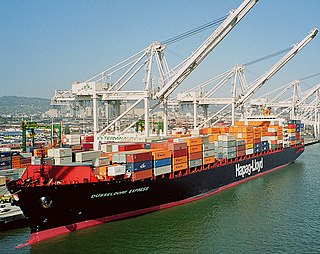
Hapag-Lloyd AG is a German international shipping and container transportation company, the 4th biggest in the world. It was formed in 1970 through a merger of Hamburg-American Line (HAPAG) and Norddeutscher Lloyd.

APL, formerly called American President Lines Ltd., is an American container shipping company that is a subsidiary of French shipping company CMA CGM. It operates an all-container ship fleet, including nine U.S. flagged container vessels.
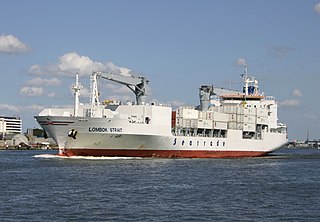
A reefer ship is a refrigerated cargo ship typically used to transport perishable cargo, which require temperature-controlled handling, such as fruits, meat, vegetables, dairy products, and similar items.

The Hamburg-Amerikanische Packetfahrt-Actien-Gesellschaft (HAPAG), known in English as the Hamburg America Line, was a transatlantic shipping enterprise established in Hamburg, in 1847. Among those involved in its development were prominent citizens such as Albert Ballin, Adolph Godeffroy, Ferdinand Laeisz, Carl Woermann, August Bolten, and others, and its main financial backers were Berenberg Bank and H. J. Merck & Co. It soon developed into the largest German, and at times the world's largest, shipping company, serving the market created by German immigration to the United States and later, immigration from Eastern Europe. On 1 September 1970, after 123 years of independent existence, HAPAG merged with the Bremen-based North German Lloyd to form Hapag-Lloyd AG.
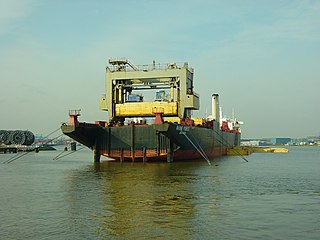
The lighter aboard ship (LASH) system refers to the practice of loading barges (lighters) aboard a bigger vessel for transport. It was developed in response to a need to transport lighters, a type of unpowered barge, between inland waterways separated by open seas. Lighters are typically towed or pushed around harbors, canals or rivers and cannot be relocated under their own power. The carrier ships are known variously as LASH carriers, barge carriers, kangaroo ships or lighter transport ships.

CP Ships was a large Canadian shipping company established in the 19th century. From the late 1880s until after World War II, the company was Canada's largest operator of Atlantic and Pacific steamships. Many immigrants travelled on CP ships from Europe to Canada. In 1914 the sinking of the Canadian Pacific steamship RMS Empress of Ireland just before World War I became largest maritime disaster in Canadian history. The company provided Canadian Merchant Navy vessels in World Wars I and II. Twelve vessels were lost due to enemy action in World War II, including the RMS Empress of Britain, which was the largest ship ever sunk by a German U-boat.
Italian Line and from 1992 Italia Line, whose official name was Italia di Navigazione S.p.A., was a passenger shipping line that operated regular transatlantic services between Italy and the United States, and Italy and South America. During the late 1960s the company turned to running cruises, and from 1981 it became a global freight operator.
Ivarans Rederi AS was a merchant steamship company founded in Norway by Ivar Anton Christensen in 1902. The flag was red with a white "C" in the middle, for the founder's family name: Christensen.

Contship Containerlines was a global container carrier operating from 1969 to 2005 in the India/Pakistan, Levant, Australia/New Zealand, South America and Asia trade, mainly to and from Europe. The company was founded just as containerization was beginning and continuously grew up with the growth of this market.

Christensen Canadian African Lines (CCAL) was a Norwegian cargo shipping company that traded between Canada and Africa between 1948 and 2000.

CSAV is a Chilean shipping company that is currently the largest company of its type in Latin America and also one of the oldest ones, having been founded in 1872.

The Moore-McCormack Lines was a series of companies operating as shipping lines, operated by the Moore-McCormack Company, Incorporated, later Moore-McCormack Lines, Incorporated, and simply Mooremack, founded in 1913 in New York City. It ceased trading on its buy-out in 1982. The founders were Albert V. Moore (1880–1953) (director/president) and Emmet J. McCormack (director/treasurer), with Mr Molloy (director/secretary).
Farrell Lines Incorporated was a boat company named in 1948 after James A. Farrell, Jr., and John J. Farrell, sons of James Augustine Farrell, president of US Steel. The company was previously known as American South African Lines (ASAL). It was a passenger line and cargo line in regular service from New York City to South Africa stopping at Cape Town, Port Elizabeth, Durban and Lourenço Marques (Maputo) in Mozambique. The ships were well-appointed and carried about 180 passengers.
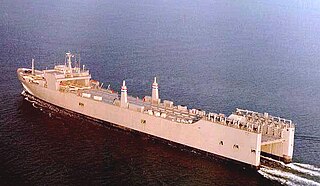
SS Cape May (T-AKR-5063) is a steam turbine powered heavy-lift Seabee barge carrier, one of two ships of her type in the Military Sealift Command's Ready Reserve Force.
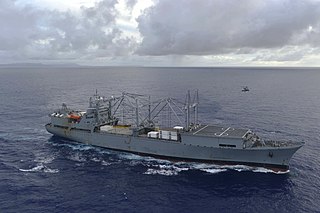
The Type C5 ship is a United States Maritime Administration (MARAD) designation for World War II breakbulk cargo and later a container ship for containerization shipments. The first type C5-class ship was a class of ships constructed and produced in the United States during World War II. The World War II C5-class ship was dry bulk cargo ship built by Bethlehem Steel in Sparrows Point, Maryland. Bethlehem Steel built eight ships in this bulk cargo class and four orders were canceled. The C5-class ship has a 24,250 DWT and was 560 feet (170 m) long. The C5 was mainly used as iron ore carriers. The C5 was needed to replace other ships that sank during World War II. First in her class was SS Venore, USMC #1982, delivered on 20 July 1945. The Type C5-class ship designed to fill the need to move iron ore from Santa Cruz, Chile, to Sparrows Point, Maryland, through the Panama Canal, a round-trip of 8,700 nautical miles . Post World War II, four ships were given C5 class type C5-S-78a, these were roll-on/roll-off container ship built by Ingalls Shipbuilding, Inc. of Pascagoula, Mississippi and operated by the Moore-McCormack Lines. The C5-S-78a had a deadweight tonnage of 16,000 tons.

Killick Martin and Company Ltd is a privately owned global transport and logistics company with its head office in the United Kingdom. The company can trace its origins back to 1861 when it was founded by Captain James Killick and James Henry Martin. The company provides ocean freight, air freight, road freight, customs clearance, warehousing and supply chain management services. The company today has 5 offices in the United Kingdom and a global network of agencies. The ultimate parent company is Atlantic Pacific Group Ltd.

Type C8-class ships are a type of Heavy Lift Barge Carrier. Type C8 ships were the 8th type of ship designed by the United States Maritime Commission (MARCOM) in the late 1960s. As done with the Type C1 ships and Type C2 ships, MARCOM circulated preliminary plans for comment. The design presented was not specific to any service or trade route. Type C8 ships measuring 876 feet (267 m) from stem to stern, and designed to make 16.2 knots.

SS Cape Mendocino (T-AKR-5064) is a steam turbine powered heavy-lift Seabee barge carrier, one of three ships of her type in the Military Sealift Command's Ready Reserve Force.

A. H. Bull Steamship Company was a shipping company and passenger liner service founded in New York City in 1902 by Archibald H. Bull (1848-1920). Service started with shipping between New York and Florida. His fleet of ships then added service to other Eastcoast ports. The company is also often called the Bull Lines and the Bull Steamship Line or A. H. Bull & Company. While founded in New York, Bull soon move its headquarter to Peir 5 in Baltimore, Maryland. Bull Lines main Eastcoast ports were: Baltimore, Charleston, Philadelphia, Tampa and Norfolk, Virginia. Oversea ports: Porto Rico, Antwerp, Bordeaux, Hamburg, Bremen, Copenhagen, and West Africa. Bull Steamship Line supported the US war effort for both World War I and World War II, including the loss of ships.

Keystone Shipping Company of Philadelphia, Pennsylvania is a major shipping and transportation company. Keystone Shipping Company operates a fleet of ships for both dry bulk cargo and tankers. Since World War I, the Keystone Shipping Company has been active in the worldwide support of the United States Armed Forces. Keystone Shipping Company is part of the Ready Reserve Fleet program. Keystone Shipping Company was founded by Charles Kurz. Before Keystone Shipping Company, Charles Kurz was a shipping agent, commodities trader, and ship owner. Keystone Shipping Company headquarters is in Bala Cynwyd, Pennsylvania.